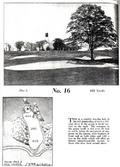Phil's Press Conference
/Sheesh, even Borat might have asked Phil Mickelson about the new penthouse timeshare he purchased overlooking the Old Course. Anyway, some highlights from his gathering with the assembled literary craftsman:
RAND JERRIS: Obviously you had success at Baltusrol last August. Would you compare this Tillinghast course to Baltusrol.
PHIL MICKELSON: Comparing Baltusrol to Winged Foot, they are very similar with bunkering, very similar shot values, the way the holes move, the challenge on the greens, very similar. They're both very difficult golf courses.
He sure knows how to wipe the smiles off the faces of those Winged Foot members.
Q. Does this course skew more to a right to left ball flight on driver holes, and if so, does that enhance your prospects this week?
PHIL MICKELSON: There are a lot of holes where you can move it either way, and right to left shots fit fine on this golf course. Left to right shots fit fine on this golf course. There are two holes where I'll be hitting a draw, the 8th hole and the 17th hole. It doesn't have to be a big draw, it just has to softly turn to the right. But other than those two holes, I'll be fading it off most every tee.
For me what it does is makes it a softer cut, takes out some of the roll and when it hits the fairway it's more inclined to stay.
A couple years ago, the USGA took 25, 30 percent out of the fairways. In '99 the fairways were 32, 34 yards wide. The last couple years they've been 24 yards. I think the widest fairway I saw was 27, 28 paces, but on average 24. So we've lost, what, a quarter of the fairways. So I'm trying to get the ball just to come in a lot softer. I don't want to hit a draw where the balls run.
He's being kind with those 27 and 28 yard figures.
Kind of sad that course setup has come to this: fast and firm would be bad because the fairways are so narrow, the balls would not stay in them.
Q. I'm wondering, there's been a lot of feedback from players about the tiers of rough and that it seems like the punishment now fits the crime a little more appropriately. I'm wondering what your thoughts are on that and whether you think that's a good evolution.
PHIL MICKELSON: Well, for me personally, the larger you hit it off line, I kind of like the way it was trampled down, but that's a personal thing. I actually think this is the way the rough probably should be, and I think it's something the Tour is probably looking at doing in the future because it makes play fair. If you miss the fairway by two yards, you're not penalized nearly as much as if you miss it by ten yards. And in the past, ten yards was a lot better off than barely missing the fairway because you'd get the trampled down effect. The rough would be walked on, you'd get a good lie, whereas two yards off the fairway, no one had been walking there, the rough had grown vertical, and the ball sits to the bottom.
I think this is a much fairer way to approach it, and it should be really good. I think that in the future the Tour may even look to that, at doing that themselves.

















